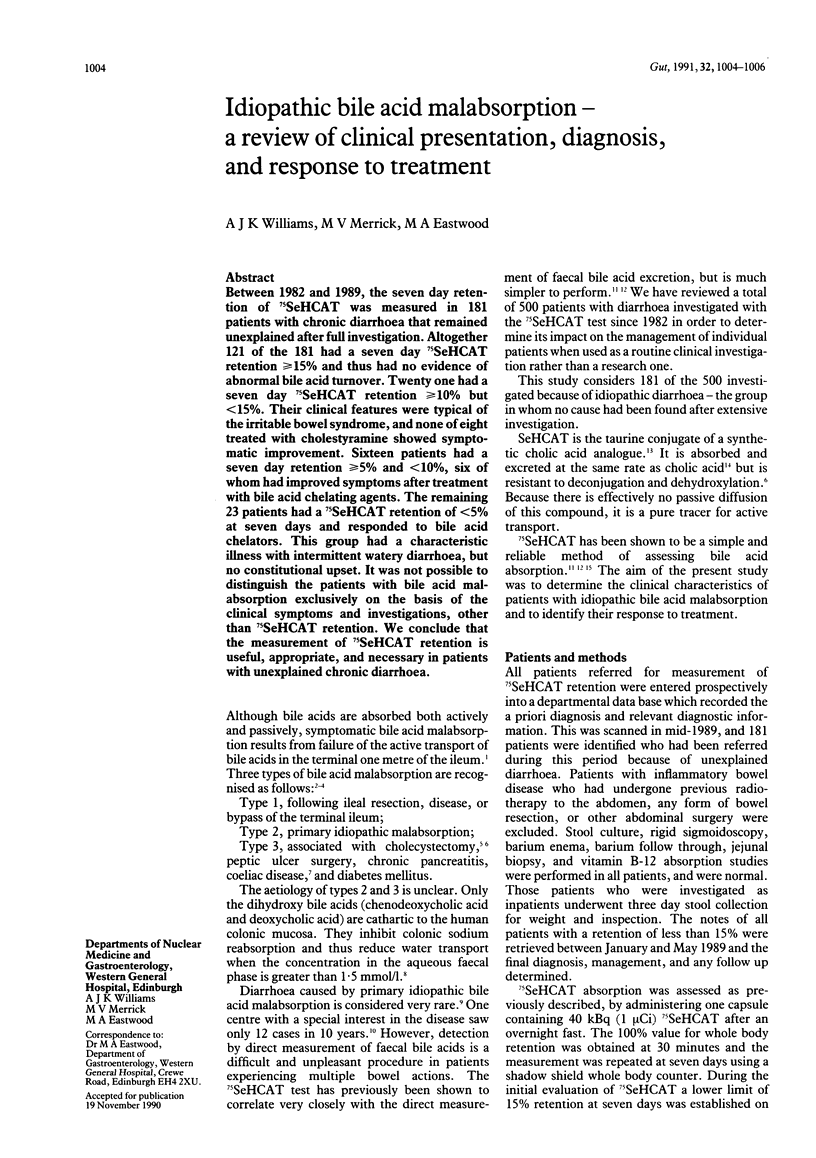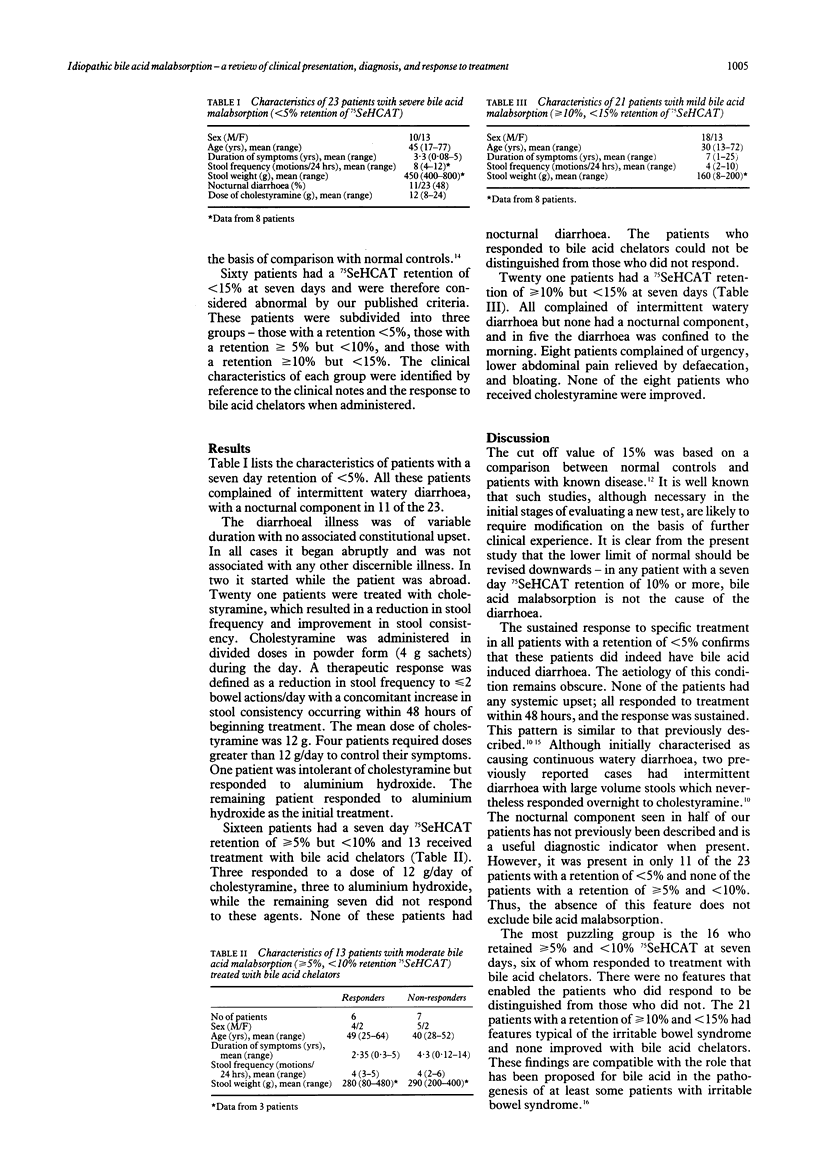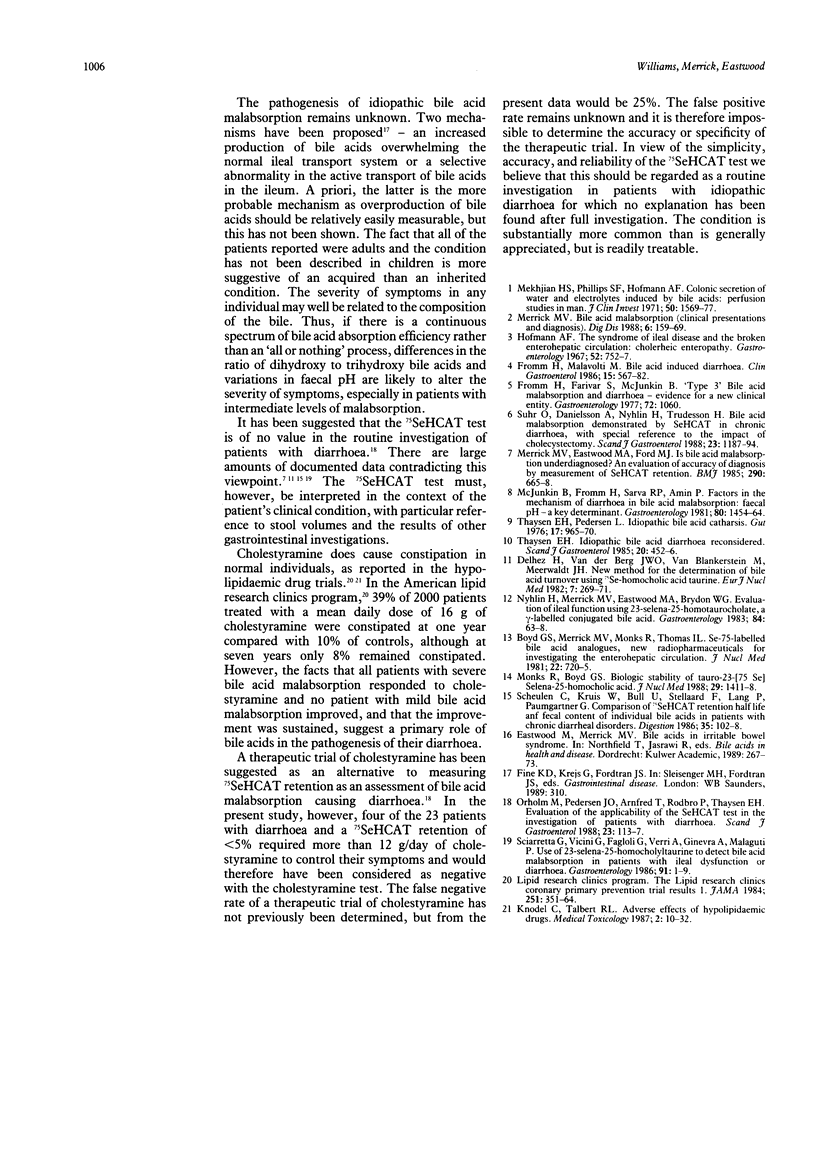Abstract
Between 1982 and 1989, the seven day retention of 75SeHCAT was measured in 181 patients with chronic diarrhoea that remained unexplained after full investigation. Altogether 121 of the 181 had a seven day 75SeHCAT retention greater than or equal to 15% and thus had no evidence of abnormal bile acid turnover. Twenty one had a seven day 75SeHCAT retention greater than or equal to 10% but less than 15%. Their clinical features were typical of the irritable bowel syndrome, and none of eight treated with cholestyramine showed symptomatic improvement. Sixteen patients had a seven day retention greater than or equal to 5% and less than 10%, six of whom had improved symptoms after treatment with bile acid chelating agents. The remaining 23 patients had a 75SeHCAT retention of less than 5% at seven days and responded to bile acid chelators. This group had a characteristic illness with intermittent watery diarrhoea, but no constitutional upset. It was not possible to distinguish the patients with bile acid malabsorption exclusively on the basis of the clinical symptoms and investigations, other than 75SeHCAT retention. We conclude that the measurement of 75SeHCAT retention is useful, appropriate, and necessary in patients with unexplained chronic diarrhoea.
Full text
PDF


Selected References
These references are in PubMed. This may not be the complete list of references from this article.
- Boyd G. S., Merrick M. V., Monks R., Thomas I. L. Se-75-labeled bile acid analogs, new radiopharmaceuticals for investigating the enterohepatic circulation. J Nucl Med. 1981 Aug;22(8):720–725. [PubMed] [Google Scholar]
- Delhez H., van den Berg J. W., van Blankenstein M., Meerwaldt J. H. New method for the determination of bile acid turnover using 75Se-homocholic acid taurine. Eur J Nucl Med. 1982;7(6):269–271. doi: 10.1007/BF00251479. [DOI] [PubMed] [Google Scholar]
- Fromm H., Malavolti M. Bile acid-induced diarrhoea. Clin Gastroenterol. 1986 Jul;15(3):567–582. [PubMed] [Google Scholar]
- Hofmann A. F. The syndrome of ileal disease and the broken enterohepatic circulation: cholerheic enteropathy. Gastroenterology. 1967 Apr;52(4):752–757. [PubMed] [Google Scholar]
- Knodel L. C., Talbert R. L. Adverse effects of hypolipidaemic drugs. Med Toxicol. 1987 Jan-Feb;2(1):10–32. doi: 10.1007/BF03259858. [DOI] [PubMed] [Google Scholar]
- McJunkin B., Fromm H., Sarva R. P., Amin P. Factors in the mechanism of diarrhea in bile acid malabsorption: fecal pH--a key determinant. Gastroenterology. 1981 Jun;80(6):1454–1464. [PubMed] [Google Scholar]
- Mekjian H. S., Phillips S. F., Hofmann A. F. Colonic secretion of water and electrolytes induced by bile acids: perfusion studies in man. J Clin Invest. 1971 Aug;50(8):1569–1577. doi: 10.1172/JCI106644. [DOI] [PMC free article] [PubMed] [Google Scholar]
- Merrick M. V. Bile acid malabsorption. Clinical presentations and diagnosis. Dig Dis. 1988;6(3):159–169. doi: 10.1159/000171192. [DOI] [PubMed] [Google Scholar]
- Merrick M. V., Eastwood M. A., Ford M. J. Is bile acid malabsorption underdiagnosed? An evaluation of accuracy of diagnosis by measurement of SeHCAT retention. Br Med J (Clin Res Ed) 1985 Mar 2;290(6469):665–668. doi: 10.1136/bmj.290.6469.665. [DOI] [PMC free article] [PubMed] [Google Scholar]
- Monks R., Boyd G. S. Biologic stability of tauro-23-[75Se] selena-25-homocholic acid. J Nucl Med. 1988 Aug;29(8):1411–1418. [PubMed] [Google Scholar]
- Nyhlin H., Merrick M. V., Eastwood M. A., Brydon W. G. Evaluation of ileal function using 23-selena-25-homotaurocholate, a-gamma-labeled conjugated bile acid. Initial clinical assessment. Gastroenterology. 1983 Jan;84(1):63–68. [PubMed] [Google Scholar]
- Orholm M., Pedersen J. O., Arnfred T., Rødbro P., Thaysen E. H. Evaluation of the applicability of the SeHCAT test in the investigation of patients with diarrhoea. Scand J Gastroenterol. 1988 Jan;23(1):113–117. doi: 10.3109/00365528809093859. [DOI] [PubMed] [Google Scholar]
- Scheurlen C., Kruis W., Büll U., Stellaard F., Lang P., Paumgartner G. Comparison of 75SeHCAT retention half-life and fecal content of individual bile acids in patients with chronic diarrheal disorders. Digestion. 1986;35(2):102–108. doi: 10.1159/000199353. [DOI] [PubMed] [Google Scholar]
- Sciarretta G., Vicini G., Fagioli G., Verri A., Ginevra A., Malaguti P. Use of 23-selena-25-homocholyltaurine to detect bile acid malabsorption in patients with illeal dysfunction or diarrhea. Gastroenterology. 1986 Jul;91(1):1–9. doi: 10.1016/0016-5085(86)90431-2. [DOI] [PubMed] [Google Scholar]
- Suhr O., Danielsson A., Nyhlin H., Truedsson H. Bile acid malabsorption demonstrated by SeHCAT in chronic diarrhoea, with special reference to the impact of cholecystectomy. Scand J Gastroenterol. 1988 Dec;23(10):1187–1194. doi: 10.3109/00365528809090189. [DOI] [PubMed] [Google Scholar]
- Thaysen E. H. Idiopathic bile acid diarrhoea reconsidered. Scand J Gastroenterol. 1985 May;20(4):452–456. doi: 10.3109/00365528509089679. [DOI] [PubMed] [Google Scholar]
- Thaysen E. H., Pedersen L. Idiopathic bile acid catharsis. Gut. 1976 Dec;17(12):965–970. doi: 10.1136/gut.17.12.965. [DOI] [PMC free article] [PubMed] [Google Scholar]


